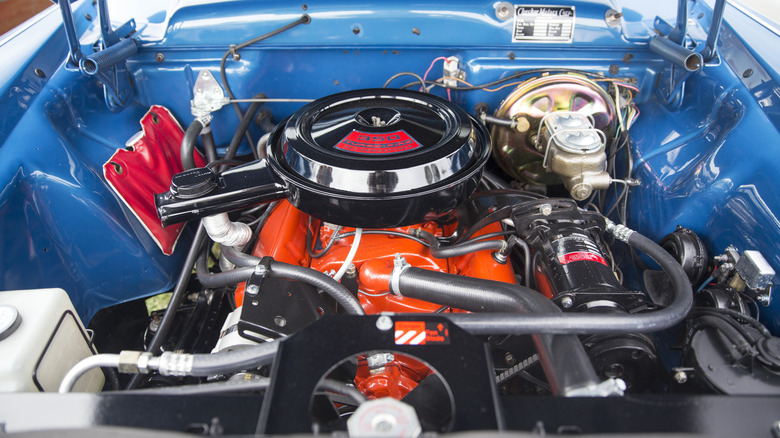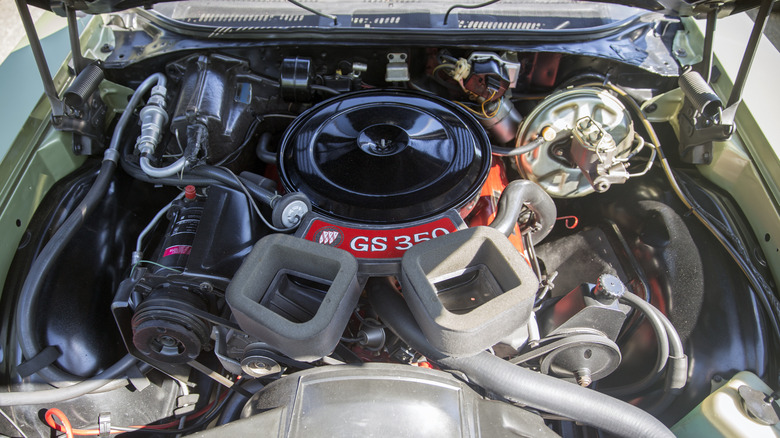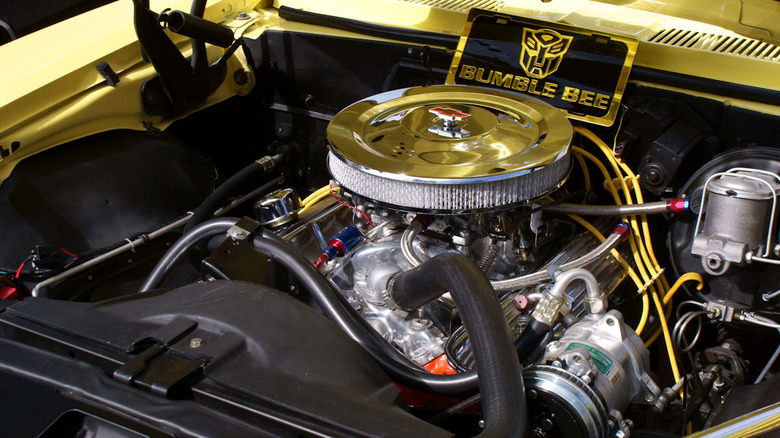Buick 350 Vs Chevrolet 350: What's The Difference?
Back in the heyday of the muscle car, just about every car company came out with a V8 engine. The big, gas-guzzling plants weren't terribly efficient or practical, but the ability to step on the gas and feel that heavy engine work was something car enthusiasts couldn't get enough of. Modern gearheads love that rumble just as much: We listed 10 popular cars in 2023 that still offered a V8 option.
The popularity of the V8 engine in the '60s and '70s was so high that, in some cases, different sections of the same company would create their own V8s, ostensibly competing against themselves. For instance, many brands owned by General Motors developed their own takes on these engines. Such is the case with the Buick 350 V8 and the Chevrolet 350 V8. However, despite the Buick and Chevy building engines at the same size with the same number of cylinders, they still had significant differences.
[Featured image by Mr.choppers via Wikimedia Commons | Cropped and scaled | CC BY-SA 3.0]
The Buick 350
Both Buick and Chevrolet separated their V8 engines into two categories: small blocks and big blocks. The 350 models for both companies were at the high end of the small-block spectrum. That's where design diverged. The Buick 350 V8, which first hit the marketplace in 1968, was created with deep-skirt cylinders, giving more support to the crankshaft, and tall, narrow cylinder heads meant to deliver better flow.
With a bore and stroke of 3.8 inches by 3.85 inches, the Buick 350 came in both two-barrel and four-barrel carburetor models, and these engines could get you a maximum of 260 hp and 285 hp, respectively. In 1970, they released an even more powerful version of the four-barrel model with an SP engine code that ramped it up to 315 hp, but that model only lasted a year.
Many Buick vehicles sported a 350 V8 over the years. In particular, the 350 would be popular among car enthusiasts who loved Buick's underrated muscle cars. Over time, the powerful, reliable plant would appear in a whole range of Buick models, from the Skylark and Gran Sport to the Electra, LeSabre, Century, and more. In the end, the Buick 350 V8 fell victim to the 1973 oil crisis, changes to emissions standards, and horsepower changes from the Society of Automotive Engineers. The last one was built in 1980.
[Featured image by Mr.choppers via Wikimedia Commons | Cropped and scaled | CC BY-SA 3.0]
The Chevy 350
While Buick basically stuck to its 350's original design throughout its 12-year run, the Chevy 350 did not. The Chevrolet 350 V8 had a far longer lifespan than its Buick counterpart. It premiered one year prior to Buick's 350 and lasted until 1997, well beyond the muscle car era it was created for. The design of the Chevy 350 was a natural evolution from the company's previous "Mighty Mouse" 327 small block engine, and it featured a bore and stroke of 4 inches by 3.48 inches. The original Chevy 350 was called the L48 and was created for the Super Sport Camaro, and it could generate up to 300 hp and 380 lb./ft. of torque. The L46 arrived two years later and upped that to 350 hp.
Chevrolet created a number of variants of the 350 over the next several years that ultimately also fell victim to the emissions restrictions and SAE horsepower rating changes, causing horsepower numbers for the engines to plummet. By 1975, the highest you could get from a 350 engine was 155 hp from the LM1 model. Chevy stuck with it, however, reworking the venerable V8 design into the Generation II small block engine, widely considered a modern classic. Alas, while its 1997 successor would be called "Generation III," it was a completely new design, not a remix of the old-school legend.
[Featured image by Valder137 via Wikimedia Commons | Cropped and scaled | CC BY 2.0]


